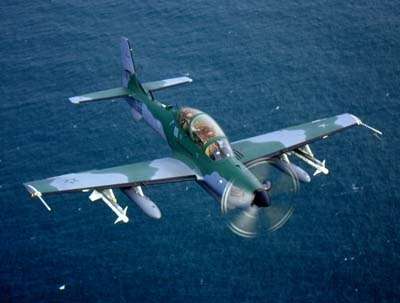Last A-29 Super Tucano And F-5M Aircraft Delivered To The FAF
Embraer said Tuesday it has successfully performed the first flight of the A-1M prototype at its manufacturing plant in Gavião Peixoto, in outstate São Paulo, during a ceremony attended by the Aeronautics Commander, Air Force General Juniti Saito, and officers from the Brazilian Air Force (FAB) High Command. The aircraft’s flight test campaign will soon begin. The A-1M program provides for refurbishing and upgrading 43 FAB AMX subsonic fighters (picured in file photo). Ten aircraft are already at the Company’s facilities and the first deliveries are planned for 2013.

The event also marked the delivery of the 99th, and last, A-29 Super Tucano light attack turboprop to the FAB, as well as the last two upgraded F-5M fighters from the first group. Via the AL-X program, the FAB became the launch customer for the Super Tucano, in December 2003. The aircraft is currently used for advanced pilot training and carries out important functions in the Amazon Surveillance System (SIVAM). The A-29 Super Tucano has been chosen by ten customers in Africa, the Americas and Asia-Pacific.
The F-5M program covers the refurbishing and upgrading of 46 supersonic fighters. Each aircraft received new navigation systems, weaponry, computers, and multimodal radar. This equipment, as well as structural repairs, increase the operational capability of the fighters for at least fifteen more years. In December 2010, a new contract was signed to upgrade 11 additional F-5 aircraft, with the work beginning on the first jet in October 2012. The first deliveries of this second group are planned for 2013.

“The A-1Ms are receiving modern systems that are similar to those already found on the F-5M and A-29 (pictured) aircraft. All of the upgrades and acquisitions are aligned with the objectives of the Aeronautics Strategic Military Planning (PEMAER)—which positions the FAB, via medium- and long-term studies—based on the National Defense Policy (PND) and on the National Defense Strategy (END). One premise of this process is the pursuit of commercial, industrial, and technological returns for developing defense materiel and strengthening the Nation’s industry,” said Aeronautics Commander, Air Force General Juniti Saito. “Therefore, our equipment makes the most of the similarity between the avionics of these aircraft, which helps with the adaptation of our pilots, and provides a level of standardization that comes with numerous operational advantages, such as improving the employment doctrine of the FAB and a better yield in terms of flight hours. Embraer’s
technical capability for meeting our needs strengthens the Air Force and, consequently, strengthens Brazil, making us ready to respond promptly to any threat to the sovereignty of our air space.”
“These achievements reinforce the commitment of Embraer Defense and Security, as a strategic partner of Brazil and, especially, of the Brazilian Air Force, and contributes to its reequipping process and the upgrading of its material resources,” said Luiz Carlos Aguiar, President of Embraer Defense and Security. “The Super Tucano gives continuity to our tradition of developing aircraft that meet Air Force requirements and, at the same time, are capable of enjoying commercial success on the foreign market, while the upgrading of the A-1 and F-5 shows our ability to develop integrated solutions, in complex systems, for our customers.”
 Senator Pushes FAA to Accelerate Rocket Launch Licensing
Senator Pushes FAA to Accelerate Rocket Launch Licensing Classic Aero-TV: RJ Gritter - Part of Aviations Bright New Future
Classic Aero-TV: RJ Gritter - Part of Aviations Bright New Future Aero-FAQ: Dave Juwel's Aviation Marketing Stories -- ITBOA BNITBOB
Aero-FAQ: Dave Juwel's Aviation Marketing Stories -- ITBOA BNITBOB ANN's Daily Aero-Linx (10.27.24)
ANN's Daily Aero-Linx (10.27.24) ANN's Daily Aero-Term (10.27.24): Clearance Void If Not Off By (Time)
ANN's Daily Aero-Term (10.27.24): Clearance Void If Not Off By (Time)




